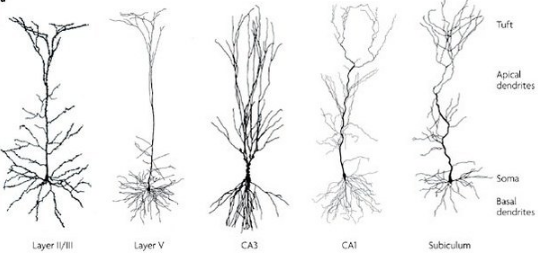Pyramidal Neuron
links: reference:
-
Large and fast human pyramidal neurons associate with intelligence
- Higher IQ correlated with lower values of dendritic density in parieto-frontal 11-10-2021
Pyramidal Cell/Neuron
 #
#
-
Characterized by typical neuron structure but with extensive branching, with connections on the order of thousands of both excitatory and inhibitory inputs. How’s that for coincidence detection?
- Therefore, considering it’s only got one axon, one of its principal actions is dendritic integration: spatiotemporal summation of synaptic potentials.
- Spatial? Yes: the more distant a synapse is from the soma, the weaker its induction of depolarization.
- Activation of a small fraction of the tens of thousands of excitatory synapses on a pyramidal neuron can probably evoke dendritic spikes, but these events do not always propagate to the soma and the axon. The coupling of dendritic spikes to axonal action-potential firing probably depends on the pattern of synaptic activation. This results in forms of coincidence detection that are determined by dendritic structure and excitability. R
- The GABAergic input is mostly on the axon and soma, while the glutamatergic is at the dendritic spine.
- Therefore, considering it’s only got one axon, one of its principal actions is dendritic integration: spatiotemporal summation of synaptic potentials.
-
Constituting ~85% of excitatory neurons, mainly found in the forebrain:
- Prefrontal Cortex PNs are implicated in cognitive ability. The complexity increases from posterior to anterior brain regions.
- Hippocampus
-
Mainly ~85% Ionotropic Glutamate Receptors and 15% being their concomitant GABA interneurons.
-
Includes retrograde signaling dendrites, i.e. Anandamide.
-
[Pyramidal Cells of the Frontal Lobe: All the More Spinous to Think With]
- Pyramidal neurons in the PFC have way more branching than the other 4 lobes. As each dendritic spine receives at least one excitatory input, the large number of spines reported for layer III cells in prefrontal cortex suggests that they are capable of integrating a greater number of excitatory inputs than layer III pyramidal cells so far studied in the occipital, parietal, and temporal lobes.